Discover the profound heritage, culture, and spiritual fervor of Kerala’s people. This famous temples in kerala serve as a source of inspiration and hope for devotees worldwide. These sacred structures are not only architectural marvels but also a testament to the rich history and traditions of the region. Kerala, known for its tranquility, is home to numerous temples that emanate a sense of peace and serenity, making them a must-visit destination for those seeking spiritual solace. Here’s a comprehensive list of the famous temples in Kerala that you shouldn’t miss.
1.Sree padmanabhaswamy temple thiruvananthapuram
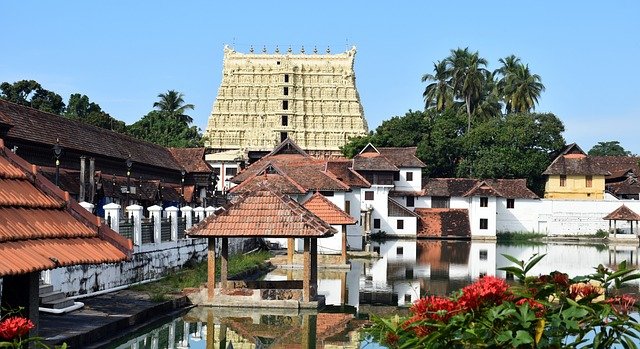
sree padmanabhaswamy temple is the one of the famous temples in kerala. The capital city of Kerala is Thiruvananthapuram, which translates to the ‘City of Lord Anantha’. One of the 108 Divya Desams, the sree padmanabhaswamy temple, is a sacred dwelling of Lord Vishnu. Only Hindus are allowed to visit sree padmanabhaswamy temple, and there is a strict dress code for both men (dhoti without a shirt) and women (sari or skirt and blouse).
In sree padmanabhaswamy temple the magnificent idol of Lord Vishnu, reclining on the five-hooded serpents known as Anantha in a deep yogic sleep, is truly captivating. The idol represents the supreme trinity of Brahma, Vishnu, and Mahesh (Shiva). Lord Brahma is depicted sitting on a lotus emerging from the navel of the statue, which is why Lord Vishnu is also known as Padmanabha, meaning lotus-navel. In the right hand of the idol, there is a Shiva lingam, symbolizing the unity of all three powers. Additionally,sree padmanabhaswamy temple is renowned as the wealthiest Indian temple in the world.
2.Guruvayur temple
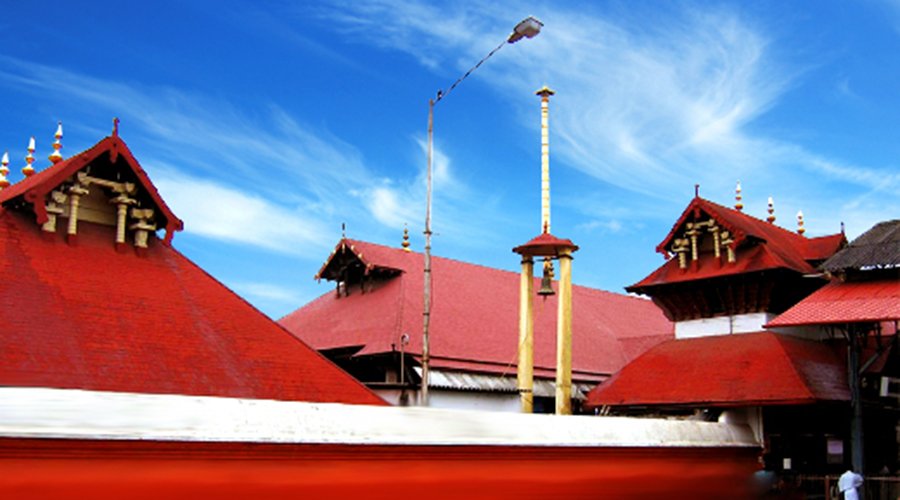
The Guruvayur Temple is a sacred Hindu site devoted to Guruvayurappan, a form of Vishnu, also known as Krishna, situated in the town of Guruvayur, Kerala, India. It holds great significance for Hindus in Kerala and Tamil Nadu, earning the name Bhuloka Vaikuntha, meaning Vaikuntha on earth. Guruvayur Temple is recognized as one of the 108 Abhimana Kshethram, a distinction within the Vaishnavate tradition.
The main symbol is a standing Vishnu with four arms, holding the Panchajanya conch, Sudarshana discus, Kaumodaki mace, and a lotus with a tulasi garland. This depiction represents the Vishnu form that appeared to Krishna’s parents Vasudeva and Devaki during his birth.
The worship rituals follow the guidelines set by Adi Shankara and later documented in the Tantric tradition, a spiritual movement that originated in medieval India. Chennas Narayanan Nambudiri, whose descendants serve as the hereditary tantris (high priests) of the Guruvayur Temple, formally recorded these practices.
The Guruvayur Temple is governed by the Guruvayur Devaswom, which operates under the jurisdiction of the Kerala state government.
Guruvayur Temple celebrates several significant festivals throughout the year, including a 10-day festival in the Malayalam month of Kumbham, starting with a flag-hoisting ceremony on the Pooyam star day; Krishna Janmashtami, commemorating the birth of Lord Krishna, in the month of Chingam; Ekadasi, the 11th day of the bright fortnight in the month of Vrischikam, also known as Guruvayur Ekadasi; and Vishu, a harvest festival, on the first day of the month of Medam.
Guruvayur Temple also has sub-deities, including Ganapati, Ayyappan, and Bhagavati, and there are two smaller temples dedicated to Ganapati and Nagadevathas (snake deities located near the main temple). Additionally, there is a replica temple called Uttara Guruvayurappan Temple in Mayur Vihar, Delhi, which is dedicated to Lord Krishna, revered as Guruvayurappan, the deity of the famous Krishna Temple in Guruvayur Town, Kerala. Guruvayur Temple holds great significance for Malayalis and Tamilians.
3.Vadakkunnathan temple-famous temples in kerala
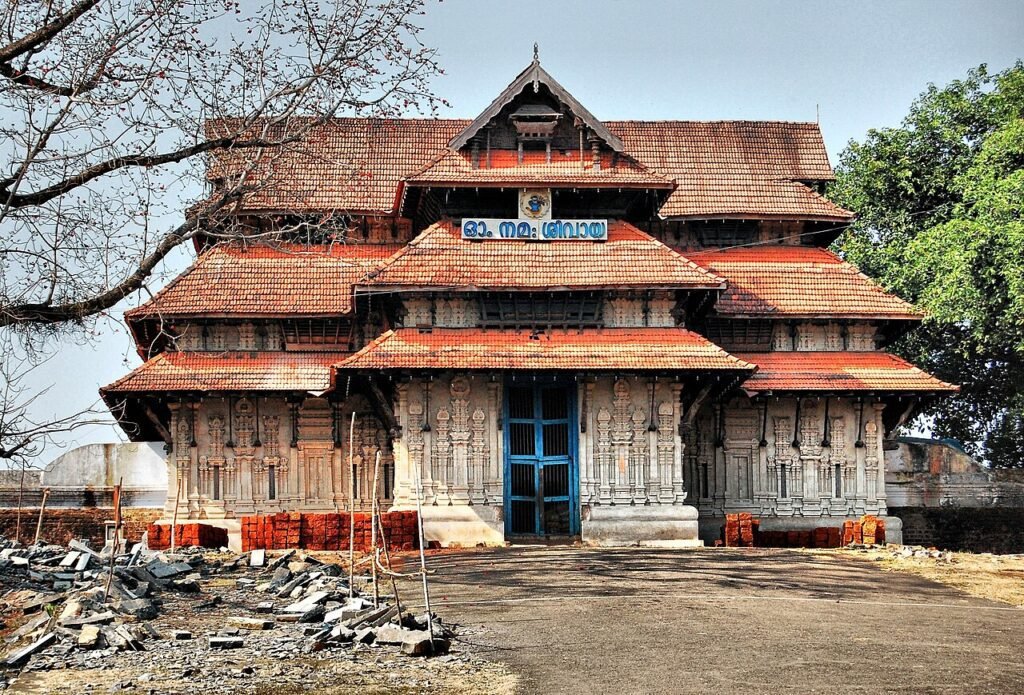
The Vadakkunnathan temple, located in Thrissur, Kerala, India, is a historic Hindu temple dedicated to Lord Shiva. The temple showcases the traditional architectural style of Kerala and features four monumental towers, one on each side, along with a koothambalam.
The interior of the Vadakkunnathan temple boasts beautiful mural paintings that depict scenes from the epic Mahabharata. The shrines and Kuttambalam of the temple are adorned with intricate wood carvings.Vadakkunnathan temple, along with its mural paintings, has been declared a National Monument by the Indian government under the AMASR Act. According to local legend, Vadakkunnathan temple was built by Parashurama, the sixth avatar of Lord Vishnu. The Thekkinkadu Maidan, surrounding the temple, serves as the main venue for the famous Thrissur Pooram festival.
The Archaeological Survey of India (ASI) suggested in 2012 that 14 locations in Kerala, such as Vadakkunnathan temple and palaces, should be considered for inclusion in the UNESCO World Heritage Sites. Among the 108 ancient Shiva Temples in Kerala, Vadakkunnathan temple is the oldest and was founded by Parashurama.
4.Kodungallur bagavathy temple
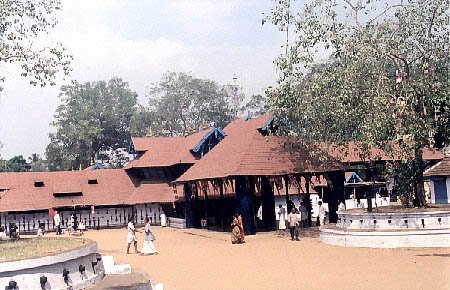
The Sree Kurumba Bhagavati Temple, also known as the Kodungallur Devi Temple, is a revered Hindu shrine located in Kerala’s Thrissur District. Dedicated to the powerful goddess Bhadrakali, a manifestation of Mahakali or Durga, the temple is considered one of the oldest functioning temples in India.
The deity is worshipped in her fierce form, facing north, with eight hands adorned with various symbols, including the head of the demon king Daruka, a sickle-shaped sword, an anklet, a bell, and others. The temple’s daily worship rituals take place between 3:00 AM and 9:00 PM local time.
The temple is frequently recognized as the authentic manifestation of Goddess Kali.[citation needed] In the time of Later Cheras, Mahodayapuram (Kodungallur) served as the capital of the Chera empire and held great significance in the area. Situated in the Thrissur district of central Kerala, the temple was constructed in a distant era and its worship embraces ancient customs of Shaktyeism that are seldom witnessed in modern Kerala temples.[citation needed]
The Kodungallur Bhagavathy temple has a rich history, passed down through generations by its priests. According to legend, the temple was originally a shrine dedicated to Lord Shiva, and it was Parasurama who installed a murti of Bhadrakali near one of Shiva’s. The goddess herself is believed to guide the priests in performing the pujas, which are considered to be of great significance.
The temple is also home to five ‘Sri Chakras’, believed to be the source of the deity’s power, installed by the revered Adi Shankaracharya. The priests who serve at the temple are Namboodiris (Tanthri) and Adikals, who have the privilege of performing ‘Pushpanjalis’ to the Goddess.
5.Sabarimala temple
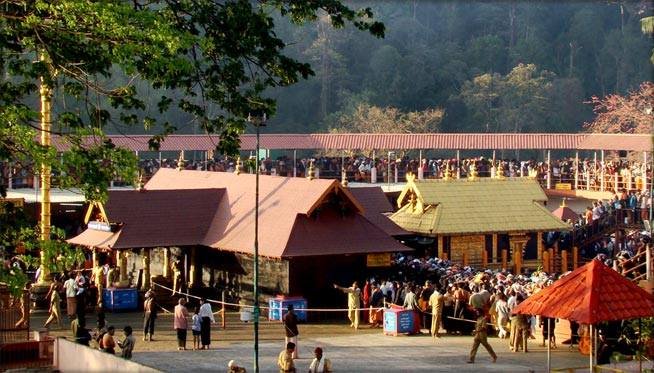
Located within the Periyar Tiger Reserve in the Pathanamthitta district of Kerala, India, the Sabarimala Sree Ayyappan Temple is a Hindu temple complex situated on the Sabarimala hill. It is renowned as one of the largest pilgrimage destinations worldwide, attracting an estimated 10 to 15 million devotees annually.
The temple is dedicated to Ayyappan, a celibate Hindu deity also known as Dharma Shasta, who is believed to be the son of Shiva and Vishnu. The Sabarimala Temple serves as a symbol of the harmonious coexistence of various religions in India.
The temple is positioned atop a hill, surrounded by 18 hills, standing at an elevation of 1,260 meters (4,134 feet) above sea level. The surrounding area is encompassed by mountains and a thick forest, which is part of the Periyar Tiger Reserve and known as Poongavanam.
The Sabarimala temple is surrounded by a thick forest in the Periyar tiger reserve. Each of the hills surrounding Sabarimala is home to temples, with some still functioning and well-preserved in places like Nilakkal, Kalaketty, and Karimala. However, there are also ancient temple remnants that can still be found on the other hills.
A Public Interest Litigation (PIL) was initiated in 1991, leading to a directive from the Kerala High Court instructing the Devaswom Board to maintain the traditional rituals of the temple. The court further clarified that there is no distinction among various groups or categories of Hindus, and the restriction on temple entry solely pertains to women of specific age groups, rather than all women in general.
On September 28, 2018, the Supreme Court of India, comprising a panel of four male judges and one female judge, delivered a 4-1 majority verdict to lift the ban on women entering the temple. However, the state of Kerala disagreed with the court’s decision.
The temple is accessible for devotees only during specific periods, including Mandala pooja (mid-November to late December), Makaravilakku or Makara Sankranti (mid-January), Maha Thirumal Sankranti (mid-April), and the initial five days of every Malayalam month. Notably, the pilgrimage involves a distinctive custom of paying respects at the mosque of Vavar, a Muslim devotee of Ayappan.
6.Ambalapuzha sree krishna temple
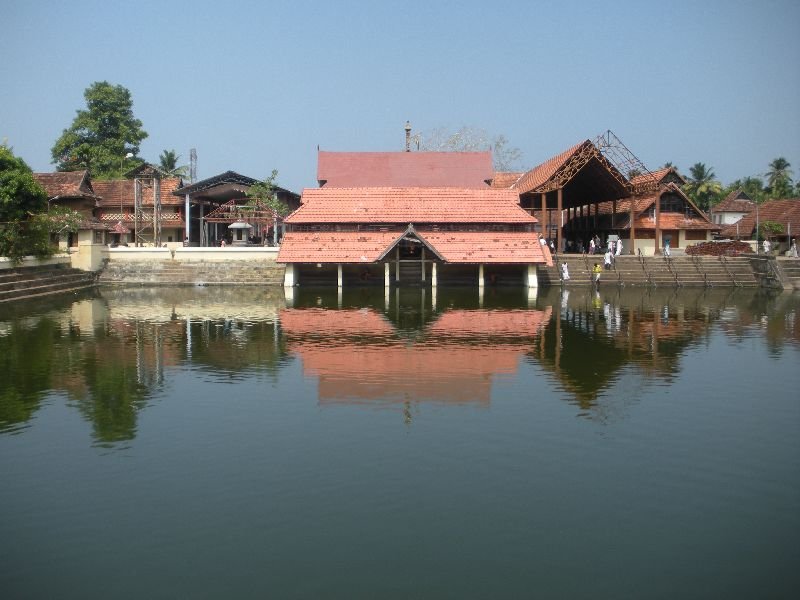
Ambalappuzha Sree Krishna Swamy Temple, located in Alappuzha district of Kerala, is a revered Hindu temple dedicated to Lord Krishna. According to historical accounts, the temple was constructed during the 15th century AD by Chembakasserry Pooradam Thirunal-Devanarayanan Thampuran, a local ruler. It is considered one of the seven most important temples in Travancore and holds great significance in the Vaishnavate tradition, being one of the 108 Abhimana Kshethram.
The deity at Ambalappuzha is compared to the Parthasarthi manifestation of Vishnu, clutching a whip in his right hand and a conch in his left. Amid the invasions led by Tipu Sultan in 1789, the Sri Krishna idol from the Guruvayur Temple was transferred to the Ambalappuzha Temple for protection for a span of three years.
In the temple, a dessert called Payasam is served. This sweet pudding is made with rice and milk and it is believed that Lord Guruvayoorappan visits the temple every day to receive this offering.
7.attukal bhagavathy temple thiruvananthapuram

The Attukal Bhagavathy Temple, located in Attukal, Kerala, India, is a Hindu religious sanctuary. Its main deity is Goddess Bhadrakali, also known as Kannaki, who is depicted riding a ‘vethala’. Bhadrakali, a form of Mahakali, is believed to have been born from Lord Shiva’s third eye and is known as the goddess of prosperity and salvation, with ‘Bhadra’ meaning good and ‘Kali’ referring to the goddess of time. T
he temple also honors Goddess Attukal Devi, who is considered the supreme mother in her aspect as Bhaadrkali Devi, representing power and courage. She is often identified with Kannaki, the protagonist of Ilanko Adikal’s ‘Silapathikaaram’. The temple is famous for the annual Attukal Pongal festival, which holds the Guinness World Record for being the largest gathering of women for a religious event, with over three million participants.
The Attukal Temple is located near the city center, around 2 kilometers from the Sree Padmanabhaswamy Temple in Thiruvananthapuram, East Fort. Devotees believe that by worshiping the goddess, their wishes will be fulfilled, and they will attain prosperity and salvation. The goddess is revered in three different forms: Maha Saraswati, the goddess of knowledge, arts, and language; Maha Lakshmi, the goddess of wealth, auspiciousness, and power; and Mahakali/Parvathy, the goddess of marriage, time, and death.
8.parassinikadavu muthappan temple

The Parassinikadavu Muthappan temple, situated on the banks of the Valapattanam river in Anthoor municipality, is a significant religious site in Kannur district, Kerala, India. The temple is located approximately 10 km (6.2 mi) from Taliparamba and 20 km (12 mi) from Kannur town.
The Thiyya community, who consider the temple’s principal deity, Sree Muthappan, as their family deity, manages the temple. Sree Muthappan’s divinity is depicted through two versions of the ritualistic theyyam enactment, Thiruvappan and Vellattam. According to local beliefs, the presiding deity is a manifestation of Lord Shiva.
is a pared-down version of the ritual performance, with a focus on the essentials. The minimal ornamentation and decorations allow for maximum emphasis on speech (vaaythari) and dance (Attam), making it a highly expressive and engaging experience. To put it into perspective, Vellattom can be likened to a deity’s idol in a temple sanctum, adhering to traditional sathwic sasthra and vedic rituals, but without the surrounding prabha-mandalam. A simpler analogy would be the Seeveli ceremony, featuring a small idol atop an elephant.
However, Thiruvappana is the complete variant, featuring regal adornments and a larger prabhamandalam. Due to the extensive and obligatory decorations, the movements are minimal and slow, and the responses to prayers, known as uriyaadal, are concise and accurate. In comparison, Thiruvappana is equivalent to a temple idol with the Prabha-mandalam encompassing it and the Seeveli procession with the large Swarna-Kolam covering the small idol atop the elephant.Muthappan is believed to be Lord Shiva in the form of a hunter.
The initial Vellattam represents Shiva in a minimal form. However, during the grand Thiruvappana of Muthappan, the Vellattom represents Vishnu in a minimal form. According to mythology, Vishnu comes to Shiva’s aid when he starts facing hardships while traveling and hunting for food with a blindfold.The temple’s rituals diverge from the conventional Satvic
Brahminical form of worship commonly seen in Hindu temples across Kerala. Instead, the primary mode of worship involves a traditional dance known as Muthappan Theyyam, which enacts both versions of Muthappan. Fish, meat, and toddy are the customary offerings made to Muthappan. The temple’s major festival, Muthappan Thiruvoppana Mahothsavam, takes place over three days every year on the 19th, 20th, and 21st of Kumbham (which falls on 3rd, 4th, and 5th of March).
9.thirunelli maha vishnu temple
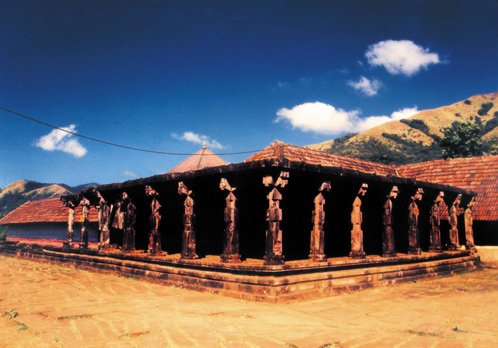
The Thirunelli Temple, also known as Tirunelli, is a historic temple located on the slopes of Brahmagiri hill in Kerala, India. It is devoted to Lord Maha Vishnu and is situated near the border with the state of Karnataka. The temple is recognized as one of the 108 Abhimana Kshethram in the Vaishnavate tradition. Nestled in a valley surrounded by picturesque mountains and forests, the temple sits at an elevation of approximately 900m in the northern region of Wayanad. It is located 32 km away from Manathavady.
